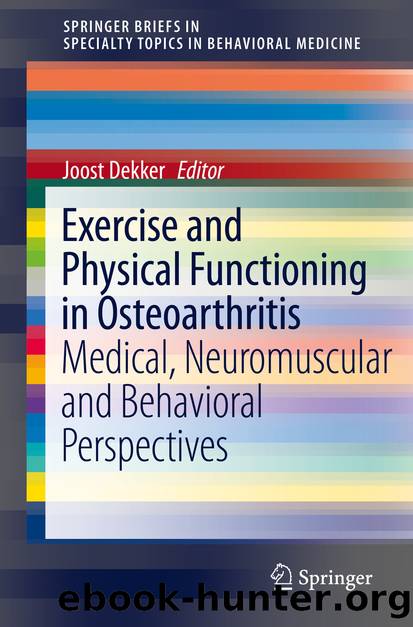Exercise and Physical Functioning in Osteoarthritis by Joost Dekker

Author:Joost Dekker
Language: eng
Format: epub
Publisher: Springer New York, New York, NY
As shown in Fig. 6.1, the model hypothesizes an indirect relationship between pain during activity and muscle weakness via avoidance of activity. Avoidance of activity is hypothesized to mediate the relationship between pain and muscle weakness. A mediator variable is conceptualized as the mechanism through which one variable influences another variable [32, 33]. Likewise, the relationship between psychological distress and muscle weakness is hypothesized to be mediated by avoidance of activity, and the relationship between avoidance and limitations in activity is hypothesized to be mediated by muscle weakness.
The avoidance model underwent some development over the past years. The model that was published in 1993 included the constructs “pain,” “negative affect,” “low activity level,” “muscle weakness,” “instability of joints,” and “disability” [28]. In the version of the model that was published in 2002, the term “low activity level” was replaced by the term “avoidance of activity,” the construct “negative affect” was not used because negative affect was not evaluated in that study, and the construct “pain-related fear” was added [29]. In the latest version of the model that was published in 2012 [34], the terminology used was adapted to the International Classification of Functioning, Disability and Health (ICF) of the World Health Organization [35] (i.e., “limitations in activity” instead of “disability”). The construct “negative affect” was reintroduced, and the component “pain-related fear” was excluded based on the reasoning that the expectation of pain is sufficient to induce avoidance of activity (see section “Similarities and Differences with the Fear-Avoidance Model”). In addition, the circular structure of the model was replaced by a linear one in order to avoid unnecessary features, which are not empirically tested [34]. In the present chapter, the term “negative affect” is replaced by “psychological distress”.
Download
This site does not store any files on its server. We only index and link to content provided by other sites. Please contact the content providers to delete copyright contents if any and email us, we'll remove relevant links or contents immediately.
The Longevity Diet by Valter Longo(5021)
The Body: A Guide for Occupants by Bill Bryson(4977)
Ikigai by Héctor García & Francesc Miralles(4125)
Limitless by Jim Kwik(3087)
The Checklist Manifesto by Atul Gawande(2782)
The Body by Bill Bryson(2572)
Memory Rescue by Daniel G. Amen(2378)
What Color Is Your Parachute? 2015 by Richard N. Bolles(2264)
Breath by James Nestor;(2231)
Becoming Myself by Irvin D. Yalom(2227)
Fat for Fuel by Joseph Mercola(1974)
Memory Rescue: Supercharge Your Brain, Reverse Memory Loss, and Remember What Matters Most by Amen Dr. Daniel G(1948)
Awakening Your Ikigai by Ken Mogi(1772)
Weight Training by Thomas Baechle(1742)
50 After 50 by Maria Leonard Olsen(1681)
Starting Over (Sugar Creek Romance ) by Jordan Silver(1653)
The Telomerase Revolution by Michael Fossel(1626)
1610396766 (N) by Jo Ann Jenkins(1625)
Dirt by Bill Buford(1613)
